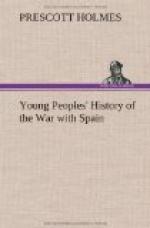When we think of the officers and men on the decks of a warship, we must not forget the force of men below the decks. The engineers, firemen and stokers do as good work, and are entitled to as much praise, as the fighting force above. In battle they are kept under the hatches, and, as a rule, never know of the progress or the result of a fight until it closes. They work in a temperature of from one hundred to one hundred and fifty degrees, by half-hour stretches. The roaring furnaces make the fire-rooms almost beyond a man’s power to endure, and we should give a great deal of our praise to the brave fellows who make the power that moves the ship.
[Illustration: The Men Who Make the Power.]
You know that we saw in the first chapter, that Spain owned another large island some miles east of Cuba—an island called Porto Rico.
This island was sighted by Columbus on November 16, 1493, and, three days later, he anchored in one of its bays. In 1510, and again a year later, Ponce de Leon visited the island and established a settlement, to which he gave the name of San Juan Bautista. Spain did not always hold it peaceably, however, for at different times the Dutch and the English tried to take it from her. The people of the island used to be terribly annoyed by pirates and buccaneers, but that was a long time ago.
The Spanish used to call San Juan the “Rich Port of John the Baptist,” and it was a great source of profit to them for nearly four hundred years. Ponce is the largest city in the island, but San Juan has the advantage of a large, protected harbor. Like Havana and Santiago, San Juan has its Morro Castle, and within its walls are the buildings of a small military town,—houses for troops, a chapel, bake-house, and guard-room, with dungeons down by the sea, and underneath it.
[Illustration: Palace and Sea-wall, San Juan, Porto Rico.]
The city of San Juan lies upon an island connected with the mainland by a bridge and a causeway. The streets are narrow, the houses are low, mostly of a single story, and are built in the old-fashioned Spanish style, with thick walls around the courtyard. The fronts are ugly and are painted all sorts of brilliant colors—pink, blue, purple and yellow. There are heavy shutters in the windows for protection, but there are no panes of glass in the town. Behind the gloomy walls are splendid gardens and courtyards, with splashing fountains, shaded by palms. The city contains a cathedral, a theatre, a city hall, the Governor-General’s palace, and several fine churches, and in the center is quite a large park, with concrete walks and seats, as with us. There is no turf, however. All around this park the market women gather every morning, selling poultry, eggs, vegetables and flowers, and in the evening there is music by a military band.




